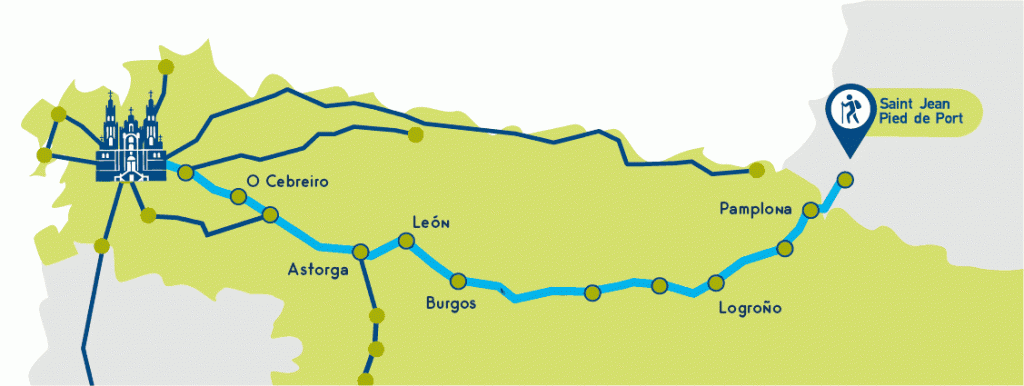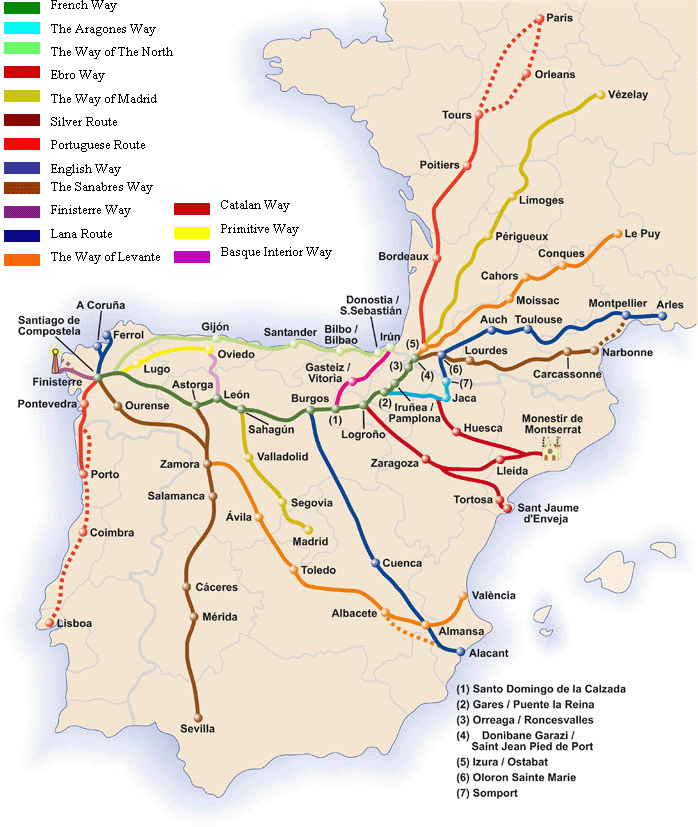The Camino Calls
Once again, I’ve been noodling about going on Camino. The Camino has been calling to me. First quietly but persistently, and now louder and insistently. Previously, we’ve walked the Camino Francés, starting in various places: Roncesvalles in 2013 (León for Francine), Saint Jean Pied de Port in 2016, and O Cebreiro in 2018.

Obviously, there are a lot of different Camino routes. In the past, we’ve talked about walking the Camino del Norte/Primitivo or the Camino Portugés. Indeed, the Portugés was a strong contender for our 2018 Camino, before we ultimately decided to walk the Galician portion of the Francés.

While I’m still drawn to both of these routes, there are two other possibilities that have been percolating in my brain recently.
The Long Camino
The first option would probably require two solid months. It would involve flying into Paris and spending some time there before taking a local flight or train to Lourdes.
After a day or so at Lourdes, the walk begins. From Lourdes to Saint Jean is about seven days, walking gently up into the Pyrenees. This has the advantage over starting in Saint Jean in two ways.
First, this means that your first day is not climbing over the pass. This is generally considered to be the most difficult single day on the Camino Francés, and it’s ludicrous to do it on day one. Yet, that’s what most folks who want to walk “the whole thing” do. I know we did. So instead of taking the pass on the first day, you get to spend a week working up to it.
Second, this really is the Way less traveled. There aren’t a lot of pilgrims on this trail. And while this means that there also aren’t a lot of options in terms of pilgrim accommodation, it also means that you are free from the crowds of pilgrims which seem to be everywhere these days.
Plus, France!
So it’s a week to Saint Jean, and roughly another five weeks to Santiago. We’d have to spend a couple of days in Santiago, of course. After that, the walk to the sea would add another three or four days.
Then a plane or train to Madrid, some days in Madrid, and a flight home from there.
Another advantage of this route is friends. Numerous folks I know are interested in walking the Camino or some portion of it with us. This would give the widest possible range of options for folks joining up and dropping off. It also provides a number of solid opportunities to meet up with European friends.
The second Camino option I’ve been noodling with is much shorter and in a different country entirely.
The Way of Saint Benedict
While there are numerous pilgrimage routes in Italy – how could there not be? – the one that calls me is the Way of Saint Benedict. It’s probably because Francine and I are Oblates of Saint Benedict. We are steeped in Benedictine spirituality, praying the Hours and reading from the Holy Rule every day.

It begins in Norcia, the birthplace of St. Benedict and site of a monastic community I’ve long wanted to visit.
Along the Way, it passes through Subiaco, the site of one of the most important monasteries that Saint Benedict founded.
The route finishes in Montecassino, the site of another of Benedict’s monasteries, and the place where he and his sister, Saint Scholastica, are entombed.
It looks to be a beautiful walk of about 16 days or so. Given that I might not be able to drop out of the rest of my life for two months, this is a definite advantage.
The other advantage of this route is that we would almost certainly bookend this walk with visits to Rome, Florence, and possibly other cities, visiting Francine’s numerous relatives along the way. We haven’t seen them since our visit in 2005, and it would be nice to catch up and meet even more cousins.
So while nothing definite is planned, I’m exploring both of these possibilities for the future.

Pingback: The Camino Calls – The World is Quiet Here
Pingback: The Camino Calls, and We Answer – Pilgrims on the Way